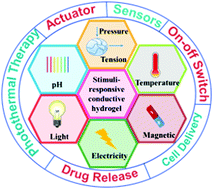Stimuli-responsive conductive hydrogels: design, properties, and applications
Abstract
Stimuli-responsive conductive hydrogels have emerged as a new rising concept in the hydrogel research field due to their combined advantages of stimuli-responsivity and conductivity from conductive polymers (such as polyaniline, polypyrrole, and polythiophene), carbon nanomaterials (such as carbon nanotubes, graphene and graphene oxide), metals (such as Au and Ag), and conductive ionic compounds (such as Fe3+ and Al3+). To summarize the recent progress relating to stimuli-responsive conductive hydrogels, this review article discusses research into the preparation, performance, and applications of stimuli-responsive conductive hydrogels published in recent decades. The types of stimuli to which these hydrogels can respond, including temperature, pH, near-infrared (NIR) light, magnetic fields, electrical fields, and multiple stimuli, are classified and discussed. Applications of stimuli-responsive conductive hydrogels in sensors for human motion/health monitoring, electronic skin, on–off switchable electronic devices, actuators, controlled drug release, wound healing, photothermal therapy, tissue engineering, and cell delivery are demonstrated. Moreover, issues still needing to be solved and future directions for the development of new types of stimuli-responsive conductive hydrogels are also proposed in this review.

- This article is part of the themed collection: 2021 Materials Chemistry Frontiers Review-type Articles


 Please wait while we load your content...
Please wait while we load your content...